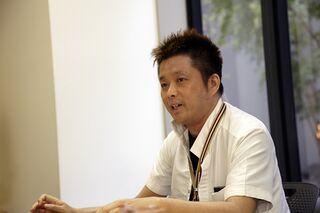Difference between revisions of "Keiichi Matsunami"
From Sega Retro
| Line 37: | Line 37: | ||
| start= | | start= | ||
| end=2023-10-31{{ref|https://archive.ph/DdNe3|https://twitter.com/SG_matsu/status/1719240904027083210}} | | end=2023-10-31{{ref|https://archive.ph/DdNe3|https://twitter.com/SG_matsu/status/1719240904027083210}} | ||
| − | | divisions= | + | | divisions=[[Sega 1st Development Division]]{{ref|https://www.hal.ac.jp/osaka/mind/special/47177}} |
}} | }} | ||
| role=Director | | role=Director | ||
Latest revision as of 14:55, 10 December 2024

|
| Keiichi Matsunami |
|---|
| Place of birth: Kobe, Japan[1] |
| Employment history: Video System
Media Design & Art
Divisions:
Divisions:
Divisions:
|
| Role(s): Director |
This teeny-tiny article needs some work. You can help us by expanding it.
Keiichi Matsunami (松並 桂一) is a director and planner at Sega. He previously worked for the companies Media Design & Art and Video System, but has worked for Sega since 2002.[2]
Career
Keiichi Matsunami and other members of Video System worked on the game 18 Wheeler: American Pro Trucker with Sega AM2. Matsunami would officially join AM2 in 2002 for the sequel The King of Route 66 and go on to direct the various versions of Quest of D.
In 2006 he directed his first rhythm game, an arcade adaptation of Nintendo's Rhythm Tengoku. Shortly after Sega Racing Classic in 2009, he directed Hatsune Miku: Project DIVA Arcade, based on the original rhythm game by Sega CS3 and Dingo, and would continue to work on the series for over 10 years (2010~2022), spanning arcades, home/handheld consoles and PC. During this period, the only game he worked on outside of Project DIVA was KanColle Arcade.
He announced his retirement from Sega on October 31, 2023.[3]
Production history
- The King of Route 66 (NAOMI 2; 2001) — Director
- Quest of D (Chihiro Satellite Terminal; 2004) — Director, Game System Design
- Quest of D: Gofu no Keisyousya (Chihiro Satellite Terminal; 2005) — Director, Game System Design
- Quest of D: Oukoku no Syugosya (Chihiro Satellite Terminal; 2005) — Director, Game System Design
- Quest of D: The Battle Kingdom (Chihiro Satellite Terminal; 2007) — Special Thanks
- Rhythm Tengoku (NAOMI; 2007) — Director
- Sega Racing Classic (RingWide; 2009) — Planner
- Hatsune Miku: Project DIVA Arcade (RingEdge; 2010) — Director, Producer, Game System Design
- Hatsune Miku: Project DIVA Dreamy Theater 2nd (PlayStation 3; 2011) — Director, Game System Design
- Daytona USA (PlayStation 3; 2011) — Planner
- Daytona USA (Xbox 360; 2011) — Planner
- Hatsune Miku: Project DIVA Dreamy Theater extend (PlayStation 3; 2012) — Director, Game System Design
- Hatsune Miku: Project Mirai 2 (Nintendo 3DS; 2013) — Director, Game System Design
- Hatsune Miku: Project DIVA Arcade Future Tone (Nu; 2013) — Executive Director
- Hatsune Miku: Project DIVA F 2nd (PlayStation 3; 2014) — Development Support
- Hatsune Miku: Project Mirai DX (Nintendo 3DS; 2015) — Rhythm Game Director
- Miracle Girls Festival (PlayStation Vita; 2015) — 技術協力 (as 松並 桂一)
- KanColle Arcade (Nu 1.1; 2016) — Director, Game System Design
- Hatsune Miku: Project DIVA Arcade Future Tone (PlayStation 4; 2016) — Executive Director
- Hatsune Miku: Project DIVA Mega Mix (Nintendo Switch; 2020) — Producer/Director
- Hatsune Miku: Project DIVA Mega Mix+ (Steam; 2022) — Producer
- Hatsune Miku: Project DIVA Mega Mix+ (Steam; 2022) — Director
- Touch Striker (Arcade; unreleased)
External links
References
- Sega-AM2 (company) employees
- Sega Corporation (2000-2015) employees
- Sega AM2 (2004-2011) staff members
- Sega R&D2 (2011-2015) staff members
- Sega Interactive (Japan) employees
- Sega Interactive R&D2 staff members
- Sega Corporation (2020) employees
- Sega 1st Development Division staff members
- Directors
- All people
- Sub-stubs